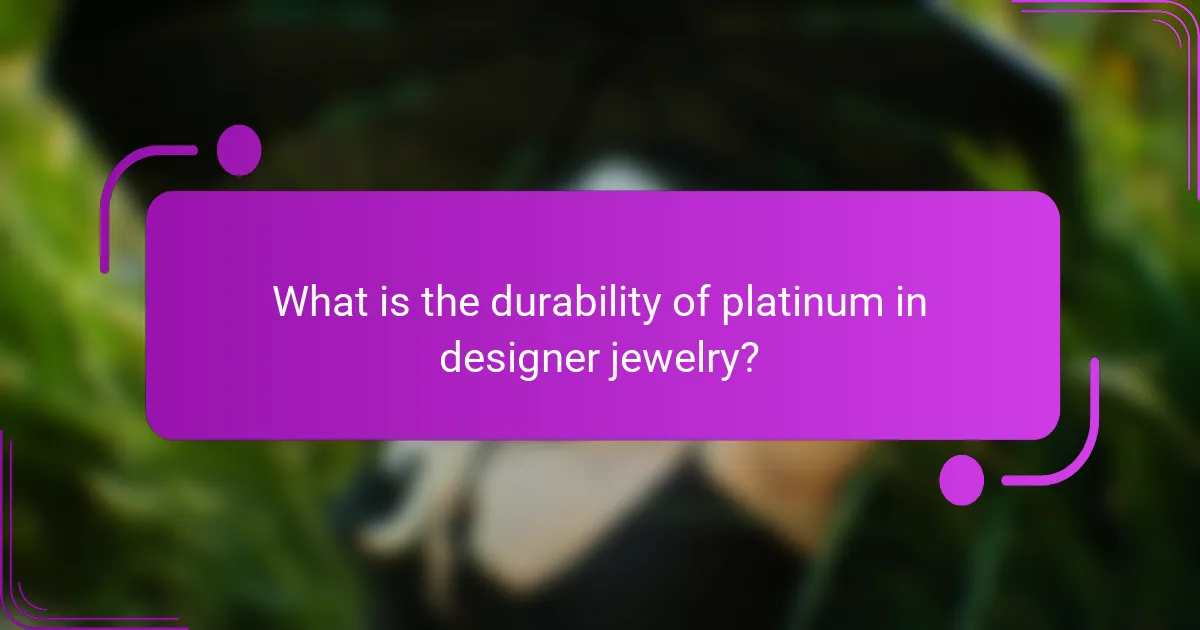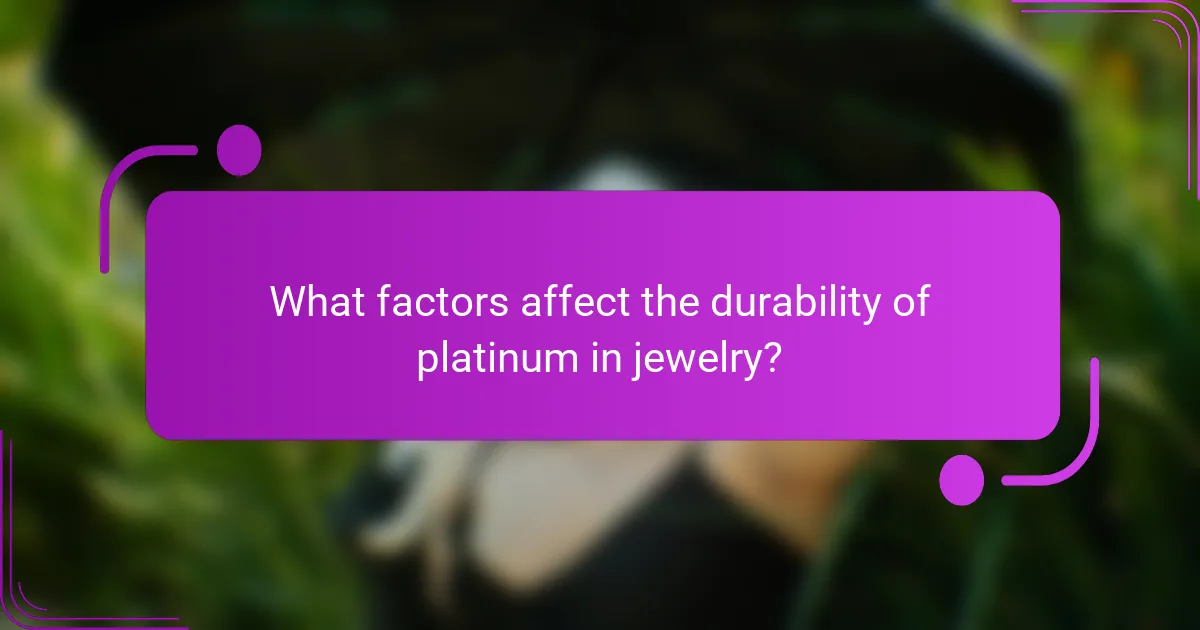Platinum is a highly durable precious metal commonly used in designer jewelry, known for its strength and resistance to scratching, tarnishing, and corrosion. Its high density contributes to its robustness, making it suitable for everyday wear, particularly in engagement rings and wedding bands. The article explores how various factors, including purity levels, alloy composition, environmental exposure, and design intricacies, influence the durability of platinum jewelry. Additionally, it highlights the importance of regular maintenance and care to preserve the metal’s longevity and appearance. Overall, the unique properties of platinum ensure that jewelry crafted from this metal can maintain its form and beauty over time.

What is the durability of platinum in designer jewelry?
Platinum in designer jewelry is highly durable. It is one of the strongest precious metals. Platinum resists scratching, tarnishing, and corrosion. This metal maintains its luster over time. It has a high density, contributing to its robustness. Additionally, platinum’s durability makes it ideal for everyday wear. Jewelry made from platinum can last a lifetime with proper care. This durability is why platinum is often chosen for engagement rings and wedding bands.
How does platinum compare to other metals in terms of durability?
Platinum is more durable than most other metals. It is highly resistant to scratching and tarnishing. This resistance is due to its dense and malleable properties. Platinum maintains its luster over time without needing frequent polishing. In comparison, gold and silver can scratch easily and require more maintenance. Additionally, platinum’s high melting point contributes to its durability in various conditions. Studies show that platinum jewelry can last a lifetime with proper care. This makes it a preferred choice for designer jewelry that is meant to endure.
What are the key properties of platinum that contribute to its durability?
Platinum is known for its exceptional durability due to several key properties. It has a high density, which contributes to its strength and resistance to wear. Platinum is also highly resistant to corrosion and tarnishing, maintaining its luster over time. Its melting point is significantly higher than that of gold, making it more suitable for intricate designs that require stability. Additionally, platinum is hypoallergenic, which means it does not cause skin reactions, ensuring longevity in jewelry. These properties make platinum a preferred choice for designer jewelry, as it withstands daily wear while retaining its beauty.
How does the purity of platinum affect its durability in jewelry?
The purity of platinum significantly affects its durability in jewelry. Higher purity platinum, such as 950 platinum, contains 95% platinum and is more resistant to tarnishing and scratching. This makes it ideal for fine jewelry, as it maintains its luster over time. In contrast, lower purity platinum, such as 850 platinum, is mixed with more alloy metals, which can reduce its overall strength. The presence of these alloys can lead to increased wear and tear. Studies show that higher purity levels correlate with better performance in daily wear scenarios. Thus, selecting higher purity platinum enhances the longevity and durability of jewelry pieces.
Why is durability important in designer jewelry?
Durability is crucial in designer jewelry because it ensures longevity and maintains aesthetic appeal. High-quality materials resist wear and tear, preserving the piece’s original beauty over time. Durable jewelry withstands daily use and environmental factors, reducing the need for repairs. This is particularly important for designer pieces, which often carry significant emotional and financial value. For example, platinum, known for its exceptional durability, is less prone to scratching and tarnishing compared to other metals. This characteristic makes platinum a preferred choice for engagement rings and heirloom pieces. Durable designer jewelry also reflects craftsmanship and quality, enhancing the brand’s reputation.
How does durability influence the longevity of designer jewelry pieces?
Durability significantly influences the longevity of designer jewelry pieces. Durable materials resist wear, scratches, and damage over time. This resistance ensures that the jewelry maintains its aesthetic appeal and structural integrity. For instance, platinum is known for its high durability compared to other metals. Platinum jewelry can withstand daily wear without losing its luster. Studies show that platinum’s density and hardness contribute to its long-lasting nature. Consequently, designer pieces made from platinum often remain in excellent condition for generations. This longevity enhances their value and desirability in the market.
What role does durability play in the value of designer jewelry?
Durability significantly enhances the value of designer jewelry. High durability ensures that pieces withstand daily wear and tear. This longevity is especially important for luxury items, as consumers expect them to last. Durable materials, like platinum, resist scratches and tarnishing, maintaining their appearance over time. A study by the Gemological Institute of America highlights that durability is a key factor in consumer purchasing decisions. Jewelry that retains its quality is often perceived as more valuable. Thus, durability directly correlates with both market demand and resale value.

What factors affect the durability of platinum in jewelry?
The durability of platinum in jewelry is affected by several factors. The purity of platinum plays a significant role. Higher purity levels, such as 950 platinum, are more durable than lower purities. The alloy composition also impacts durability. Common alloy metals, like iridium or ruthenium, enhance strength and resistance to scratching.
Environmental exposure can affect platinum’s durability. Chemicals, moisture, and extreme temperatures may lead to wear over time. The design and craftsmanship of the jewelry influence its resilience. Intricate designs may be more susceptible to damage than simpler ones.
Regular maintenance is crucial for preserving durability. Proper cleaning and care can prevent buildup that weakens the metal. Lastly, the frequency of wear affects durability. Jewelry worn daily experiences more wear compared to pieces worn occasionally.
How do environmental factors impact platinum’s durability?
Environmental factors significantly impact platinum’s durability. Platinum is highly resistant to corrosion and tarnish, which contributes to its longevity. However, exposure to extreme temperatures can alter its structural integrity. High humidity can promote the formation of surface oxides, affecting its appearance. Additionally, exposure to harsh chemicals can lead to surface degradation. Platinum’s durability is also influenced by mechanical stress from everyday wear. Understanding these factors helps in maintaining platinum’s aesthetic and structural qualities in jewelry.
What effects do chemicals have on platinum jewelry?
Chemicals can cause tarnishing and discoloration of platinum jewelry. Common substances like chlorine and bleach can lead to surface damage. Additionally, exposure to harsh cleaning agents may degrade the jewelry’s finish. Platinum is resistant to corrosion, but certain chemicals can still affect its appearance. Regular cleaning with mild soap and water is recommended to maintain its luster. Avoiding contact with chemicals can prolong the life of platinum jewelry.
How does exposure to heat influence the durability of platinum?
Exposure to heat can significantly influence the durability of platinum. High temperatures can cause platinum to lose its hardness. This loss of hardness may lead to deformation or scratching. Platinum has a melting point of approximately 1,768 degrees Celsius. However, prolonged exposure to temperatures above 1,000 degrees Celsius can weaken its structure. This weakening can result in reduced durability over time. Additionally, heat can cause discoloration, affecting the aesthetic appeal of platinum jewelry. Therefore, careful handling is essential to maintain the durability of platinum in designer jewelry.
What care practices can enhance the durability of platinum jewelry?
Regular cleaning enhances the durability of platinum jewelry. Use a mild soap solution and a soft brush to remove dirt. Rinse thoroughly with warm water and dry with a soft cloth. Avoid harsh chemicals that can damage the metal. Store platinum jewelry in a soft pouch or separate compartment to prevent scratches. Remove jewelry before engaging in activities that may cause damage. Regular inspections by a jeweler can identify and address wear and tear. These practices help maintain the jewelry’s luster and structural integrity over time.
How should platinum jewelry be cleaned to maintain its durability?
Platinum jewelry should be cleaned with warm soapy water and a soft brush. This method effectively removes dirt and oils without damaging the metal. Use a mild dish soap for best results. Rinse thoroughly under warm water to eliminate any soap residue. Dry the jewelry with a soft, lint-free cloth. Regular cleaning helps maintain the jewelry’s shine and prevents tarnishing. Avoid harsh chemicals and abrasive materials, as they can scratch the platinum. Following these steps ensures the longevity and durability of platinum jewelry.
What storage tips can help protect platinum jewelry from damage?
Store platinum jewelry in a soft cloth pouch or a separate compartment of a jewelry box. This prevents scratches from contact with other jewelry. Use a jewelry box with a lined interior to cushion the pieces. Keep platinum away from harsh chemicals, as they can damage the metal’s surface. Avoid storing platinum in damp areas to prevent tarnishing. Regularly clean the jewelry with a soft cloth to maintain its shine. These practices help preserve the integrity and appearance of platinum jewelry.

What are the unique attributes of platinum that enhance its durability?
Platinum possesses unique attributes that significantly enhance its durability. One key attribute is its high density, making it resistant to wear and tear. Platinum is also highly resistant to corrosion and tarnishing. This resistance is due to its chemical stability, which allows it to maintain its appearance over time. Additionally, platinum has a melting point of 1,768 degrees Celsius, which contributes to its strength under high temperatures. Its malleability allows it to be shaped without breaking, making it ideal for intricate designs in jewelry. These properties collectively ensure that platinum jewelry retains its form and beauty for a lifetime.
What makes platinum resistant to scratching and tarnishing?
Platinum is resistant to scratching and tarnishing due to its high density and unique molecular structure. This metal has a hardness rating of 4-4.5 on the Mohs scale, making it more durable than gold or silver. The dense atomic structure of platinum allows it to withstand wear and tear over time. Additionally, platinum does not oxidize, which prevents tarnishing. Unlike other metals, platinum maintains its luster without the need for plating or frequent polishing. This inherent resistance is why platinum is often chosen for fine jewelry. Its durability ensures that pieces remain beautiful and intact for generations.
How does the molecular structure of platinum contribute to its durability?
The molecular structure of platinum enhances its durability through its dense atomic arrangement. Platinum has a face-centered cubic crystal structure, which contributes to its high density and strength. This structure allows for strong metallic bonding among atoms, making it resistant to deformation. Additionally, platinum’s electron configuration provides stability against corrosion and tarnishing. The presence of a complete d-subshell in its electron configuration results in minimal reactivity with environmental elements. Studies show that platinum maintains its luster and integrity over time, even in harsh conditions. This combination of structural strength and chemical stability makes platinum an ideal choice for durable jewelry.
Why is platinum considered hypoallergenic and how does this affect its use in jewelry?
Platinum is considered hypoallergenic because it contains very low levels of other metals. This characteristic makes it less likely to cause allergic reactions in sensitive individuals. Platinum is a pure metal, typically 90-95% pure in jewelry, minimizing the risk of skin irritation. Many people with metal allergies can wear platinum without experiencing discomfort. This hypoallergenic property enhances its appeal for fine jewelry, especially in engagement rings and wedding bands. Consumers often seek platinum for its durability and skin-friendly qualities. Studies show that platinum jewelry is preferred by those with sensitivities to metals like nickel. Thus, its hypoallergenic nature positively impacts its use in jewelry design.
What are some rare attributes of platinum that impact its durability?
Platinum has several rare attributes that significantly enhance its durability. One such attribute is its exceptional resistance to corrosion and tarnish. This resistance is due to platinum’s high density and inert nature, which prevents it from reacting with most chemicals. Another rare attribute is its ability to withstand high temperatures without losing structural integrity. Platinum maintains its strength and shape even under extreme heat, making it ideal for settings in designer jewelry. Additionally, platinum has a unique property of being malleable yet strong. This allows it to be shaped and crafted without breaking, ensuring longevity in jewelry designs. These attributes collectively contribute to platinum’s reputation as a durable and long-lasting material in the jewelry industry.
How does the rarity of platinum as a metal affect its desirability in jewelry design?
The rarity of platinum significantly enhances its desirability in jewelry design. Platinum is approximately 30 times rarer than gold, making it a prestigious choice. Its limited availability creates a sense of exclusivity. This exclusivity appeals to consumers seeking unique and high-value pieces. Additionally, platinum’s durability and resistance to tarnish contribute to its allure. Jewelry made from platinum maintains its luster over time, adding to its long-term value. The combination of rarity and durability positions platinum as a premium material in the luxury jewelry market.
What unique design features can be achieved with platinum’s durability in mind?
Platinum’s durability allows for intricate and long-lasting design features in jewelry. Its resistance to scratching and tarnishing enables fine detailing that maintains its appearance over time. Designers can create complex settings for gemstones without fear of damage. Platinum’s malleability allows for unique shapes and forms that can be crafted with precision. The metal’s weight provides a substantial feel, enhancing the perception of quality. Additionally, platinum can be alloyed with other metals for varied finishes, offering a range of aesthetic options. These characteristics make platinum ideal for heirloom pieces meant to last generations.
What practical tips can enhance the understanding of platinum’s durability in jewelry?
Platinum’s durability in jewelry can be enhanced through several practical tips. First, consider the metal’s natural resistance to tarnish and corrosion. This property makes platinum an ideal choice for everyday wear. Regular cleaning with a mild soap and water solution helps maintain its shine. Avoid exposure to harsh chemicals, as they can damage the metal’s surface. Store platinum jewelry separately to prevent scratches from harder materials. Additionally, choose settings that protect gemstones to prevent them from loosening. Understanding these aspects reinforces the perception of platinum as a long-lasting option in jewelry.
The main entity of this article is platinum, specifically its durability in designer jewelry. The article provides an in-depth examination of platinum’s key properties that contribute to its strength, including its resistance to scratching, tarnishing, and corrosion. It compares platinum to other metals, highlights the impact of purity on durability, and discusses environmental factors that can affect its longevity. Additionally, the article outlines care practices that enhance platinum’s durability, unique attributes that differentiate it, and the significance of durability in the value of designer jewelry.